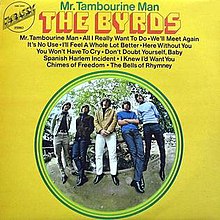| Mr. Tambourine Man | ||||
|---|---|---|---|---|
 | ||||
| Studio album by | ||||
| Released | June 21, 1965 | |||
| Recorded | January 20, March 8 – April 22, 1965 | |||
| Studio | Columbia, Hollywood | |||
| Genre | ||||
| Length | 31:35 | |||
| Label | Columbia | |||
| Producer | Terry Melcher | |||
| The Byrds chronology | ||||
| ||||
| Singles from Mr. Tambourine Man | ||||
| ||||
| Alternate cover | ||||
 Cover of the 1974 Embassy Records reissue[nb 1] | ||||
Mr. Tambourine Man is the debut studio album by the American rock band the Byrds, released on June 21, 1965, by Columbia Records.[1] The album is characterized by the Byrds' signature sound of Jim McGuinn's[nb 2] 12-string Rickenbacker guitar and the band's complex harmony singing.[2] The material on the album mostly consists of cover versions of folk songs, primarily composed by Bob Dylan, and originals written or co-written by singer Gene Clark.[3] Along with the Dylan-penned single of the same name, Mr. Tambourine Man established the band as an internationally successful act[4] and is widely regarded by critics as representing the first effective American challenge to the chart dominance of the Beatles and other British Invasion bands during the mid-1960s.[3][5]
The album was also influential in popularizing the musical subgenre known as folk rock, by melding intelligent lyrical content with electric guitars and a rock backbeat.[4][2] The term "folk rock" was first coined by the American music press to describe the Byrds' sound in mid-1965, around the same time that the Mr. Tambourine Man album was released.[6] The band's hybrid of a British Invasion beat, jangly guitar playing, and poetic or socially conscious lyrics influenced a number of acts in the mid-1960s and has also been influential on successive generations of musicians.[3][7][8]
The album peaked at number 6 on the Billboard Top LPs chart and reached number 7 in the United Kingdom. It is the band's most successful album on either chart.[9][10] The "Mr. Tambourine Man" single was released ahead of the album in April 1965 and reached number one on the Billboard Hot 100 and the UK Singles Chart.[10][11] A second single, "All I Really Want to Do", also a Dylan cover, was moderately successful in the U.S., but fared better in the UK, where it reached the top ten.[10][11]
Cite error: There are <ref group=nb> tags on this page, but the references will not show without a {{reflist|group=nb}} template (see the help page).
- ^ Rogan, Johnny (1998). The Byrds: Timeless Flight Revisited (2nd ed.). Rogan House. p. 545. ISBN 0-9529540-1-X.
- ^ a b Unterberger, Richie. "Mr. Tambourine Man album review". AllMusic. Rovi Corp. Retrieved 2009-09-21.
- ^ a b c Unterberger, Richie. "The Byrds Biography". AllMusic. Rovi Corp. Retrieved 2009-11-02.
- ^ a b Rogan, Johnny (1996). Mr. Tambourine Man (CD booklet). The Byrds. New York City: Columbia/Legacy. pp. 11–15.
- ^ Fricke, David (1996). "The Chimes of Freedom". Mr. Tambourine Man (CD booklet). The Byrds. New York City: Columbia/Legacy. pp. 7–9.
- ^ Rogan, Johnny (1998). The Byrds: Timeless Flight Revisited (2nd ed.). Rogan House. pp. 81–87. ISBN 0-9529540-1-X.
- ^ Cite error: The named reference
folkrockwas invoked but never defined (see the help page). - ^ Levith, Will (21 May 2013). "10 Acts That Owe The Byrds A Round". Diffuser.fm. Townsquare Media. Retrieved 2017-11-16.
- ^ Whitburn, Joel (2002). Top Pop Albums 1955-2001. Record Research Inc. p. 121. ISBN 0-89820-147-0.
- ^ a b c Brown, Tony (2000). The Complete Book Of The British Charts. London: Omnibus Press. p. 130. ISBN 0-7119-7670-8.
- ^ a b Whitburn, Joel (2008). Top Pop Singles 1955-2006. Record Research Inc. p. 130. ISBN 978-0-89820-172-7.